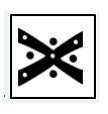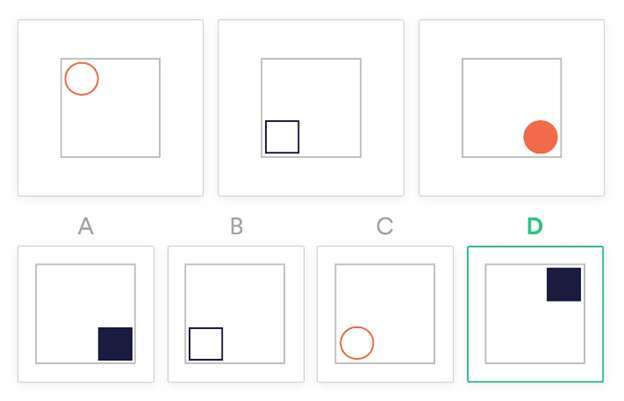
Inductive reasoning tests involve recognizing the relationships between shapes and figures to spot rules and patterns, and to apply these rules to achieving the correct answer.
Patterns have to do with alternation, rotation, reflection, replacement or translation, or all of these combined together.
This category of test presents employers with an understanding of how you think and how you handle new rules and scenarios.
They can reveal your levels of creativity and your ability to learn and apply new information, and also evaluate your general intelligence.
The inductive reasoning test can be applied for recruitment in all types of positions, but are particularly well suited for roles involving science, IT, and engineering.
To excel in an inductive reasoning test, you must be able to apply open-minded and explorative thinking skills, trying out various possible solutions in your head to arrive at the correct answer.
Important Facts about Inductive Reasoning Tests
Let’s take a look at important facts and tips about the inductive reasoning test to assist you in passing the real test:
- What does an inductive reasoning test measure?
An inductive reasoning test is used to measure your ability to approach difficult situations and solve problems.
Your ability to work flexibly with unfamiliar information will also be measured using this test category.
If you can perform well on the inductive reasoning test, you will develop the ability to think analytically and conceptually.
- The most popular inductive reasoning tests that hiring managers use today are what?
SHL uses the inductive reasoning test for commercial purposes as against other test publishers who apply different descriptions even though SHL’s format and theirs may look the same.
Such other descriptions with similar formats include abstract reasoning, logical reasoning, and diagrammatic reasoning.
As a candidate, instead of getting confused at these formats of the inductive reasoning test, you should contact the employer or company who offers the test you are about to take.
The company will be very helpful and will likely give you at least more information about the nature of the test.
The most popularly inductive test publishers you will likely see today include:
- Why practicing the inductive reasoning test is so important
Practice will surely make you perfect. This same is applicable to an inductive reasoning test. You may get shocked when you are presented with these test questions for the first time, especially when you haven’t come across anything related to the inductive reasoning test before.
This will definitely make you score poorly because you don’t have any experience with the test pattern.
However, if you have the opportunity to see the inductive reasoning test first before tackling its questions, you will get fully prepared on the test day.
You will have a better chance of success if you practice your inductive reasoning skills in advance.
It’s important to practice seeing there are various elements of the test that could trip you up.
You will always improve your skills if you take enough time to practice the test, and you will also get a better understanding of what’s involved in the inductive reasoning test.
Displaying your skills in inductive reasoning will actually help you if you want to get that job of your dream.
You’ll be much more confident with the test if you practice it first.
- How can you differentiate inductive reasoning from deductive reasoning?
Inductive logic differs greatly from deductive logic. Deductive reasoning involves exploring and discounting possible outcomes so as to arrive at the only possible outcome without disagreeing with the given premises.
The Sudoku puzzle is a very good example of deductive reasoning. It assesses your ability to reach general conclusions based on perceived patterns observed in specific events.
Inductive reasoning on the other hand is open and analytic. It’s about reaching a general conclusion about your perception of patterns observed in specific events.
Inductive reasoning involves real-life scenarios and conversations, making the test popular with employers.
- What is the inductive reasoning test all about?
The inductive reasoning test is all about identifying patterns that are present in a series of graphics.
The pattern may involve alternation, translation, rotation, replacement, or reflection.
Practice will help you learn to look for these transformations, which should apply to each item in the sequence when you must have come up with the pattern.
What makes the inductive reasoning test so popular in the world today is that it’s entirely international and no language barrier exists as it’s merely symbolic.
- Practice will improve your inductive reasoning test performance
As popularly said, the concept of the inductive reasoning test is to use it and judge the candidate’s logical problem-solving proficiency.
So, candidates searching for technical and engineering positions should be ready for the test.
Practice will help you spot patterns from the sequences of images or graphics, and observe the variables and the disparity that happens across the sequence.
You will notice that the knowledge of the inductive reasoning test will help you figure out the patterns in the graphics.
Therefore, for you to improve your inductive reasoning test performance, you need to practice in order to work accurately and quickly. There are free sample tests you can practice to help you get the experience that this requires.
- Tips to help you on the inductive reasoning test
There are some tips that you should consider before taking an inductive reasoning test. These include:
- Take as many practice as possible
Because of the importance of practice, you should always give yourself the time to properly prepare before taking the inductive reasoning test in order to know where your skill level actually lies.
Practicing in advance will also allow you to improve your reaction time and general test score.
At the end of this article are some inductive reasoning sample questions and answers that will help you know how the test will look like.
- Take your time
Remember the significance of time management in a timed test. You don’t need to hurry through the test questions or else you will make mistakes.
You will rather have better opportunities of answering the questions correctly if you will take your time to decipher each image for the pattern being displayed.
- Keep calm
Practicing ahead of the test will help you stay calm when taking a timed logical thinking test.
Don’t panic if you can’t provide the answer to any question immediately.
With the full answer explanations in your practice test session, you can easily break down any pattern you will come across during the course of the testing process.
- How to prepare for an inductive reasoning test
Do lots of practice in order to prepare for an inductive reasoning test, as this will help you get acquainted with the types of questions you will meet.
You will also be able to develop the strategies and methods required to deal with the question types so you will not panic on the day you will take the test.
You will have adequate knowledge of what you are going to face when you research properly for the test and check with the recruiter what type of test to anticipate.
It will also be beneficial to find out who the test providers are, so that you can visit the appropriate website to get an insight into the format and content of the test questions that you are likely to meet.
- What does the inductive reasoning test involve?
An inductive reasoning test has to do with a set of figures and shapes that conform to a specific logical rule of a pattern.
You will need to identify these logical ties or estimate the pattern and use them to look for the correct answer.
- Where can I practice an inductive reasoning test?
There are a number of websites where you can practice the inductive reasoning test online that can help you achieve high results and understand how an inductive reasoning test works.
- What is the inductive reasoning test used for?
The inductive reasoning test is used to assess your logical thinking to know how well and fast you can identify relations, patterns, and similarities in groups of shapes.
The inductive reasoning test was created with the aim of evaluating your level of problem-solving skills and your ability to adapt to new situations.
- How is the inductive reasoning test scored?
The inductive reasoning test requires that you establish logical relations and identify patterns in shapes and figures.
Your score will be determined by the number of correct answers you got.
In addition, your score may be measured up to the results of the others or results of the normative group.
- Who are the employers that use an inductive reasoning test?
The inductive reasoning test is one of the most common types of aptitude tests that are meant to evaluate your logical thinking in unknown scenarios crucial for almost every category of job.
Therefore, employers from both big enterprises and small businesses make use of the inductive reasoning test with the aim of hiring candidates for various job positions.
- How difficult is the inductive reasoning practice test?
The inductive reasoning practice test, just like the ones offered by major test publishers, is standardized in one layout and format.
The complexity of the test differs from graduate scheme level to senior management level.
There is a unique personal progress tracking system that allows you to track your performance and compare your scores to those of your peers.
- Tips for passing the inductive reasoning test
Here are some tips that will assist you if you would like to pass the inductive reasoning test.
These include:
- Watch your timing
- Practice in an exam condition
- Learn to spot patterns
- Do your research
- Be competitive
- Remain focused and don’t get distracted by unrelated information
- Be accurate
- Keep away from spending too much time on a particular question
- Practice as often as you can
- Work backward if you struggle with a particular method
- Make an educated guess where necessary.
- SHL inductive reasoning test
The SHL inductive reasoning is a 25-minute long test, with questions that are made up of 5 symbols following a pattern.
Candidates are then asked to select the missing symbol from a collection of multiple-choice options.
- Kenexa inductive reasoning test
This test looks almost the same as the SHL inductive reasoning test, with 25 questions provided to be answered within 20 minutes.
The questions of this test will be based on identifying the rule governing a series of figures, in which you will be required to choose the missing figure.
- Talent Q inductive reasoning test
In this test, you will be provided with a series of symbols following a logical pattern in which you will need to decide what comes next.
The questions are multiple-choice and the more questions you answer accurately the more difficult the questions become.
This test has more answer options than most other tests, around 7 to 14 for each question.
As an adaptive test, it gets more complex as you keeping answering the questions correctly.
- AON discovering rules
This test can also be called scales ix, with 20 questions to be completed within 5 minutes. You will be presented with a series of figures or images in each question following a rule in which you will be asked to decide the one figure that doesn’t match.
- What does an inductive reasoning test contain?
The concept behind the inductive reasoning test is to test your logical problem-solving ability.
It is a type of psychometric test frequently used in hiring applicants for job roles such as IT and engineering.
In order to spot patterns in the sequence of graphics, you will have to think logically against the timer.
Spotting a pattern in the first two or three figures and quickly testing out your theory by checking if this fits with the next figures is the best way you can tackle the inductive reasoning test.
This can be possibly done with the help of constant practice.
Inductive Reasoning Test Practice Questions and Answers
Below are sample inductive reasoning questions. These questions come in the same style as what you will see on the real inductive reasoning test.
These questions and the following answer explanations will help you get used to the format of the test and style for answering the questions.
Question One

Which of the shapes below continues the sequence?

The answer is:

All triangles “move” somewhat counter-clockwise and outside. An idea you can use in solving this challenge is to disassemble the complete figure to its elements, which are triangles.
You can then focus each time on a specific element.
Question Two

Which of the shapes below continues the sequence?

The answer is:

The logic: An X shape has black and white dots. The two sets of dots are not dependent on each other and follow the same pattern.
A black dot is added counter-clockwise to each frame that is placed in the angles of the X shape until all the angles are occupied.
Then a dot is decreased, also counter-clockwise. The same pattern happens with the white dots, only in a clockwise method.
Studying the alterations before and after, the “question mark” figure is supposed to look the same as in frame 2, only with an additional black dot (making all 4 black dots present) and an extra white dot in the upper right corner, as determined by the pattern.
Question Three
In the following sequence, which optional image would come next?

The answer is D. The shapes are moving around the corners in an anti-clockwise way. So, D is the only shape that is in the correct position.
Conclusion
An inductive reasoning test is a tool for pre-employment assessment used for screening and selection.
It is a common type of aptitude test that you are likely to receive as part of your psychometric test.
These categories of psychometric tests are designed to measure your problem-solving abilities, or ability to apply logical reasoning.
It’s vital to note that inductive reasoning is about competence and skill and so it can be improved through practice.
Through practicing the inductive reasoning psychometric test online, you can improve your logical and inductive reasoning abilities so as to be able to solve the inductive reasoning test items you will be presented within your real psychometric test.




